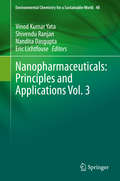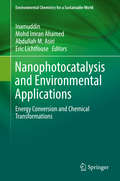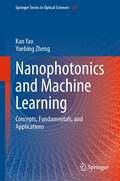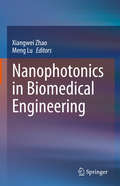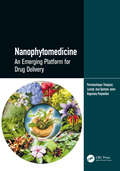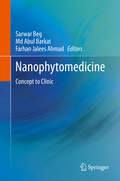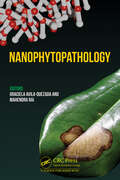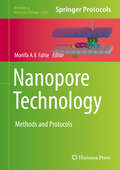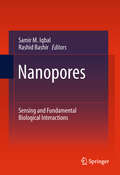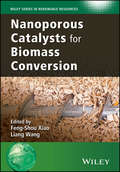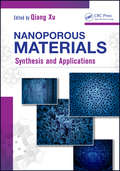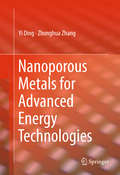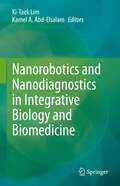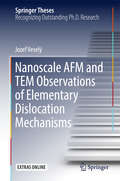- Table View
- List View
Nanopharmaceuticals: Principles and Applications Vol. 3 (Environmental Chemistry for a Sustainable World #48)
by Eric Lichtfouse Shivendu Ranjan Nandita Dasgupta Vinod Kumar YataThis book is the third volume on this subject and focuses on the recent advances of nanopharmaceuticals in cancer, dental, dermal and drug delivery applications and presents their safety, toxicity and therapeutic efficacy. The book also includes the transport phenomenon of nanomaterials and important pathways for drug delivery applications. It goes on to explain the toxicity of nanoparticles to different physiological systems and methods used to assess this for different organ systems using examples of in vivo systems.
Nanophenomena at Surfaces
by Michail MichailovThis book presents the state of the art in nanoscale surface physics. It outlines contemporary trends in the field covering a wide range of topical areas: atomic structure of surfaces and interfaces, molecular films and polymer adsorption, biologically inspired nanophysics, surface design and pattern formation, and computer modeling of interfacial phenomena. Bridging "classical" and "nano" concepts, the present volume brings attention to the physical background of exotic condensed-matter properties. The book is devoted to Iwan Stranski and Rostislaw Kaischew, remarkable scientists, who played a crucial role in setting up the theoretical fundamentals of nucleation and crystal growth phenomena in the last century.
Nanophotocatalysis and Environmental Applications: Detoxification and Disinfection (Environmental Chemistry for a Sustainable World #30)
by Eric Lichtfouse Inamuddin Abdullah M. AsiriThis book will be a guiding path to understand the photocatalytic process and mechanism for the deterioration of heavy metals, persistent organic pollutants and pathogens from wastewater. Environmental remediation is of crucial importance in the context of human sustainability in the present and future times. The unplanned anthropogenic activities and revolutionary industrialization end up in environmental contamination with noxious organic-inorganic and biogenic pollutants. The photocatalytic disinfection and detoxification is the only solution to preserve and restore the ecological balance. The main emphasis is to explore and enhance the photocatalytic potentials of solar active-materials.
Nanophotocatalysis and Environmental Applications: Energy Conversion and Chemical Transformations (Environmental Chemistry for a Sustainable World #31)
by Eric Lichtfouse Inamuddin Abdullah M. Asiri Mohd Imran AhamedThis book presents photocatalysis as a state-of-art technology in energy production and conversion. The ever increasing demand for energy with growing economies has led to a dearth of energy sources. The exhaustive dependability on non-renewable resources of energy has not just depleted them but also lead to the birth of secondary problems such as pollution and climate change. The photoactive processes have opened a new window for the production of green energy and helped in environmental sustainability. The harnessing of renewable sources especially sun and water for fuel production and noxious gases reduction solve both the issues of pollution mitigation and energy crisis.
Nanophotonic Chemical Reactions: New Photochemical Reactions and Their Applications (Nano-Optics and Nanophotonics)
by Takashi YatsuiThis book introduces readers to the cutting-edge topic of nanophotonic photochemical reactions and their applications. From among the various innovations in optical technology achieved by means of the non-uniform optical near field, it focuses on photochemical reactions at the nanoscale. Optical near fields are the elementary surface excitations of nanometric particles with non-uniform field distributions. After reviewing the unique properties of the non-uniform optical field, the book presents a range of applications of near-field assisted photochemical reactions, including near-field etching, visible water splitting, carbon dioxide reduction and reactions in solar cells.
Nanophotonics (Springer Series In Optical Sciences #213)
by Arthur McGurnThis book gives a readable introduction to the important, rapidly developing, field of nanophotonics. It provides a quick understanding of the basic elements of the field, allowing students and newcomers to progress rapidly to the frontiers of their interests. Topics include: The basic mathematical techniques needed for the study of the materials of nanophotonic technology; photonic crystals and their applications as laser resonators, waveguides, and circuits of waveguides; the application of photonic crystals technology in the design of optical diodes and transistors; the basic properties needed for the design and understanding of new types of engineered materials known as metamaterials; and a consideration of how and why these engineered materials have been formulated in the lab, as well as their applications as negative refractive index materials, as perfect lens, as cloaking devices, and their effects on Cherenkov and other types of radiation. Additionally, the book introduces the new field of plasmonics and reviews its important features. The role of plasmon-polaritons in the scattering and transmission of light by rough surfaces and the enhanced transmission of light by plasmon-polariton supporting surfaces is addressed. The important problems of subwavelength resolution are treated with discussions of applications in a number of scientific fields. The basic principles of near-field optical microscopy are presented with a number of important applications. The basics of atomic cavity physics, photonic entanglement and its relation to some of the basic properties of quantum computing, and the physics associated with the study of optical lattices are presented.
Nanophotonics and Machine Learning: Concepts, Fundamentals, and Applications (Springer Series in Optical Sciences #241)
by Kan Yao Yuebing ZhengThis book, the first of its kind, bridges the gap between the increasingly interlinked fields of nanophotonics and artificial intelligence (AI). While artificial intelligence techniques, machine learning in particular, have revolutionized many different areas of scientific research, nanophotonics holds a special position as it simultaneously benefits from AI-assisted device design whilst providing novel computing platforms for AI. This book is aimed at both researchers in nanophotonics who want to utilize AI techniques and researchers in the computing community in search of new photonics-based hardware. The book guides the reader through the general concepts and specific topics of relevance from both nanophotonics and AI, including optical antennas, metamaterials, metasurfaces, and other photonic devices on the one hand, and different machine learning paradigms and deep learning algorithms on the other. It goes on to comprehensively survey inverse techniques for device design, AI-enabled applications in nanophotonics, and nanophotonic platforms for AI. This book will be essential reading for graduate students, academic researchers, and industry professionals from either side of this fast-developing, interdisciplinary field.
Nanophotonics in Biomedical Engineering
by Meng Lu Xiangwei ZhaoThis book summarizes the latest advances in nanophotonics for biomedical applications, including biomolecular sensing and imaging, additive fabrications, and biophotonics. The engineering of nanophotonics will have significant impacts on the life sciences and medicine alike. Given its scope, the book offers a valuable asset for researchers, scientists, engineers, and graduate students in the fields of biomedical engineering, electrical engineering, materials sciences, optics, biology, and medicine.
Nanophotonics, Nanooptics, Nanobiotechnology, and Their Applications: Selected Proceedings of the 6th International Conference Nanotechnology and Nanomaterials (NANO2018), August 27-30, 2018, Kyiv, Ukraine (Springer Proceedings in Physics #222)
by Leonid Yatsenko Olena FesenkoThis book highlights some of the latest advances in nanotechnology and nanomaterials from leading researchers in Ukraine, Europe, and beyond. It features contributions from participants in the 6th International Science and Practice Conference Nanotechnology and Nanomaterials (NANO2018) in Kiev, Ukraine on August 27-30, 2018 organized by the Institute of Physics of the National Academy of Sciences of Ukraine, University of Tartu (Estonia), University of Turin (Italy), and Pierre and Marie Curie University (France). Internationally recognized experts from a wide range of universities and research institutions share their knowledge and key results on nanooptics, energy storage and biomedical applications. This book's companion volume also addresses topics such as materials properties, behavior, and synthesis.
Nanophysics for Energy Efficiency
by Rui F. M. LoboThis book provides a succinct account of the ways in which nano technology is being applied to improve energy efficiency. The coverage includes current scanning probe techniques for electrical energy storage, energy harvesting systems and local electrochemistry as well as emerging techniques of relevance to diverse materials and devices, including advanced scanning probes for nano fabrication and nano tribology. The tools of nanotechnology, such as scanning probe microscopes and micro machines, can provide important information about the fundamental nature of space, especially the zero-point electromagnetic field. An exciting aspect of this subject is that a better understanding of the force that arises from the zero-point field, i. e. , the Casimir force, may enable its control to some extent, impacting on the development of nano electromechanical systems. Readers will find this book to be a clear and concise summary of the state of the art in nanophysics and nanotechnology as they relate to energy efficiency.
Nanophytomedicine: An Emerging Platform for Drug Delivery
by Parimelazhagan Thangaraj Lucindo Jose Quintans Junior N. PonpandianNanophytomedicine is a branch of medicine that involves the application of nanomedicine-based systems to phytotherapy and phytopharmacology and the use of phytonanoparticles for biomedical applications. Nanophytomedicine covers recent advances in experimental and theoretical studies on various properties of nanoparticles derived from plant sources. This book assesses the recent advancements and applications of plant-based nanoparticles and also highlights emerging concepts of biomimetics. The book contains 24 chapters encompassing various therapeutic applications of phytochemicals derived from plants, ferns, seaweeds, and so on, mediated through nanotechnology and its allied approaches. A fervent attempt has been made to compile every significant advancement in the field of phytonanomedicine so as to accelerate its momentum in the pharmaceutical sector.
Nanophytomedicine: Concept to Clinic
by Sarwar Beg Farhan Jalees Ahmad Md Abul BarkatNanophytomedicine is a field that involves the application of nanomedicine-based systems to phytotherapy and phytopharmacology. This book assesses the clinical successes and failures of nanophytomedicine and also highlights emerging concepts in this field. The content is divided into three sections, the first of which describes core issues in the pharmaceuticals industry in connection with the successes, failures and prospects of nanophytomedicine. The second section highlights recent advances in phytomedicine formulation development based on nanotechnology approaches, while also discussing a variety of nanocarrier systems for the successful delivery of phytomedicines. Focusing on the clinical perspective, the third section addresses the current clinical status of nanophytomedicine as a single drug therapy or combinatorial drug therapy, pharmacovigilance, pharmacokinetics, drug interactions and toxicological profiles, while also providing concluding remarks on recent experimental findings, and considering ethical issues & regulatory challenges in nanophytomedicine. Given its scope, the book offers a valuable guide for early career researchers, young scientists, master level students, academics and industrial scientists working in various healthcare fields, e.g. the pharmaceutical and biological sciences, life sciences, biotechnology, biomedical engineering, and nanobiotechnology.
Nanophytopathology
by Mahendra Rai Graciela Avila-QuezadaThe book entitled ‘Nanophytopathology’ discusses the need for alternative technologies particularly smart nanotechnological tools including nanobiosensor in the detection of plant diseases, delivery of fungicides/pesticides, and therapy for the diseases caused by plant pathogens and pests. The use of nanomaterials will minimize the huge amount of application of pesticides and fungicides thereby reducing environmental pollution. This technology is eco-friendly, economically viable, and useful for sustainable crop production. The book encompasses chapters written by experienced experts in respective fields, which provide up-to-date knowledge about pathogen/pest control using nanotechnology. It will be essential reading for post-graduate students and researchers, agriculture scientists, nanotechnologists, microbiologists, green chemistry experts, and biotechnologists.
Nanoplasmonic Sensors
by Alexandre DmitrievThis book is a compendium of the finest research in nanoplasmonic sensing done around the world in the last decade. It describes basic theoretical considerations of nanoplasmons in the dielectric environment, gives examples of the multitude of applications of nanoplasmonics in biomedical and chemical sensing, and provides an overview of future trends in optical and non-optical nanoplasmonic sensing. Specifically, readers are guided through both the fundamentals and the latest research in the two major fields nanoplasmonic sensing is applied to - bio- and chemo-sensing - then given the state-of-the-art recipes used in nanoplasmonic sensing research.
Nanopore Technology: Methods and Protocols (Methods in Molecular Biology #2186)
by Monifa A. V. FahieThis detailed collection explores techniques involved in the main strategies of nanopore sensing, such as translocation, analyte trapping, and interactions with external binding sites. Opening with a section on nanopore design and nanopore production, the book continues with parts devoted to various biological nanopores, nanopore engineering, and their uses in single molecule sensing, computational methods to study intrinsic nanopore behavior, characterizing the specific translocation activity of a vesicle particle through a nanopore, as well as the use of the technique droplet interface bilayer (DIB) in nanopore and membrane biophysical studies. Written for the highly successful Methods in Molecular Biology series, chapters include introductions to their respective topics, lists of the necessary materials and reagents, step-by-step, readily reproducible laboratory protocols, and tips on troubleshooting and avoiding known pitfalls. Authoritative and practical, Nanopore Technology: Methods and Protocols, with its focus on nanopore technology and biomolecule characterization, will hold the interest of the biophysicists, biochemists, bioengineers, and molecular biologists who are working toward further understanding this key field of research.
Nanopore-Based Technology
by Maria E. GrachevaNanopores are vital biological features, described as tiny holes in cellular membranes used for recognition and transport of ions and molecules between compartments within the cell, as well as between the extracellular environment and the cell itself. Their study, ever growing in esteem, leads toward the promise of ultra-fast sequencing of DNA molecules with the ultimate goal of building a nanoscale device that will make rapid and cheap DNA sequencing a reality. In Nanopore-Based Technology, expert researchers in the forefront of the field explore the cutting-edge of nanopore technology for single molecule sensing, detection, and characterization. Divided into four convenient parts, this volume covers single molecule characterization techniques utilizing biological pores, methods for biomolecule characterization with nanoporous artificial membranes, computational studies of the biomolecule confined within the nanopore environment, as well as techniques that use novel materials in conjunction with nanopore sensing. Written for the highly successful Methods in Molecular BiologyTM series, this work provides the kind of detailed description and implementation advice that is crucial for achieving optimal results. Authoritative and state-of-the-art, Nanopore-Based Technology serves as an excellent representation of the present-day available techniques for biomolecule characterization with nanoporous membranes in order to guide researchers toward developing the next generation of technologies for fast and cheap DNA sequencing with practically no limitations on the read lengths.
Nanopores
by Rashid Bashir Samir M. IqbalNanopores are nanometer scale holes formed naturally by proteins or cells, and can be used for a variety of applications, including sequencing DNA and detecting anthrax. They can be integrated into artificially constructed encapsulated cells of silicon wafers while allowing small molecules like oxygen, glucose and insulin to pass, while keeping out large system molecules. "Nanopores: Sensing and Fundamental Biological Interactions" examines the emerging research directions surrounding nanopores such as genome sequencing and early disease detection using biomarker identification. Covering the applications of nanopores in genetics, proteomics, drug discovery, early disease detection and detection of emerging environmental threats, it is a must-have book for biomedicalengineers and research scientists.
Nanoporous Carbons for Soft and Flexible Energy Devices (Carbon Materials: Chemistry and Physics #11)
by Francesca Borghi Francesca Soavi Paolo MilaniThis book provides an interesting snapshot of new research within the fields of flexible and soft devices which use porous carbon-based materials. The increase in demand for soft and flexible electronics, electrochemical energy storage/conversion systems, piezoresistive pressure sensors has promoted the development of new strategies for the synthesis and integration of nanoporous carbon (NPC) into flexible and soft polymers and inorganic textures. The structural properties of such NPC materials combined with their mechanical, conductive and catalytic properties, show promising results for the technology they are designed for, which can be useful solutions in many other disciplines. An in-depth discussion of the use of NPC materials in different energy devices is provided in every chapter, while at the same time the knowledge of the reader on the various applications where these materials can be used will be broadened. This book sheds new light on nanoporous carbon-based materials and will be of great interest to graduate students and professionals working in this field.
Nanoporous Catalysts for Biomass Conversion
by Liang Wang Christian V. Stevens Feng-Shou XiaoA comprehensive introduction to the design, synthesis, characterization, and catalytic properties of nanoporous catalysts for the biomass conversion With the specter of peak oil demand looming on the horizon, and mounting concerns over the environmental impact of greenhouse gas emissions, biomass has taken on a prominent role as a sustainable alternative fuel source. One critical aspect of the biomass challenge is the development of novel catalytic materials for effective and controllable biomass conversion. Edited by two scientists recognized internationally for their pioneering work in the field, this book focuses on nanoporous catalysts, the most promising class of catalytic materials for the conversion of biomass into fuel and other products. Although various catalysts have been used in the conversion of biomass-derived feedstocks, nanoporous catalysts exhibit high catalytic activities and/or unique product selectivities due to their large surface area, open nanopores, and highly dispersed active sites. This book covers an array of nanoporous catalysts currently in use for biomass conversion, including resins, metal oxides, carbons, mesoporous silicates, polydivinylbenzene, and zeolites. The authors summarize the design, synthesis, characterization and catalytic properties of these nanoporous catalysts for biomass conversions, discussing the features of these catalysts and considering future opportunities for developing more efficient catalysts. Topics covered include: Resins for biomass conversion Supported metal oxides/sulfides for biomass oxidation and hydrogenation Nanoporous metal oxides Ordered mesoporous silica-based catalysts Sulfonated carbon catalysts Porous polydivinylbenzene Aluminosilicate zeolites for bio-oil upgrading Rice straw Hydrogenation for sugar conversion Lignin depolymerization Timely, authoritative, and comprehensive, Nanoporous Catalysts for Biomass Conversion is a valuable working resource for academic researchers, industrial scientists and graduate students working in the fields of biomass conversion, catalysis, materials science, green and sustainable chemistry, and chemical/process engineering.
Nanoporous Materials: Advanced Techniques for Characterization, Modeling, and Processing
by Nick KanellopoulosHaving successfully replaced elements used in traditional, pollution-prone, energy-consuming separation processes, nanoporous materials play an important role in chemical processing. Although their unique structural or surface physicochemical properties can, to an extent, be tailored to meet specific process-related requirements, the task of charac
Nanoporous Materials: Synthesis and Applications
by Qiang XuIn the past two decades, the field of nanoporous materials has undergone significant developments. As these materials possess high specific surface areas, well-defined pore sizes, and functional sites, they show a great diversity of applications such as molecular adsorption/storage and separation, sensing, catalysis, energy storage and conversion,
Nanoporous Metals for Advanced Energy Technologies
by Yi Ding Zhonghua ZhangThis book covers the state-of-the-art research in nanoporous metals for potential applications in advanced energy fields, including proton exchange membrane fuel cells, Li batteries (Li ion, Li-S, and Li-O2), and supercapacitors. The related structural design and performance of nanoporous metals as well as possible mechanisms and challenges are fully addressed. The formation mechanisms of nanoporous metals during dealloying, the microstructures of nanoporous metals and characterization methods, as well as miscrostructural regulation of nanoporous metals through alloy design of precursors and surface diffusion control are also covered in detail. This is an ideal book for researchers, engineers, graduate students, and government/industry officers who are in charge of R&D investments and strategy related to energy technologies.
Nanoproteomics
by Steven A. Toms Robert J. WeilAs two relatively new fields of study, proteomics and nanotechnology have developed in parallel with each other to allow an increased precision in the identification of post-translational protein modifications as well as to provide a more automated isolation and detection of rare proteins in both serum and tissues. The Nanoproteomics: Methods and Protocols volume organizes and collects technical advances from leaders in the field to make laboratory protocols more readily available and understandable to those who are attempting to incorporate nanotechnologic techniques into their proteomic research. Conveniently divided into five sections, this detailed volume covers preliminary sample preparation, nanoscale fluidic devices and methods, nanostructured surfaces and nanomaterials, and nanoproteomic techniques to detect and understand protein and proteomic alterations specific to human pathology. Written in the highly successful series entitled Methods in Molecular BiologyTM, these chapters include introductions to their respective topics, lists of the necessary materials and reagents, step-by-step laboratory protocols that are readily reproducible, and tips on troubleshooting and avoiding known pitfalls. Convenient and authoritative, Nanoproteomics: Methods and Protocols offers key procedures that are culled from the laboratories of leaders in the field of nanoproteomics with the aim of helping researchers in their standardization and proliferation of protocols that will lead to a more wide scale adoption and smoother progress in this vital field.
Nanorobotics and Nanodiagnostics in Integrative Biology and Biomedicine
by Kamel A. Abd-Elsalam Ki-Taek LimNanorobotics and Nanodiagnostics in Integrative Biology and Biomedicine "Nanorobotics and nanodiagnostics” can be defined as a new generation of biohybrid and nanorobotics that translate fundamental biological principles into engineering design rules, or integrative living components into synthetic structures to create biorobots and nanodiagnotics that perform like natural systems. Nanorobots or nanobots are structured of a nanoscale made of individual assemblies. They can be termed as intelligent systems manufactured with self-assembly strategies by chemical, physical and biological approaches. The nanorobot can determine the structure and enhance the adaptability to the environment in interdisciplinary tasks."Nanorobotics and nanodiagnostics" is a new generation of biohybrid that translates fundamental biological principles into engineering design rules to create biorobots that perform like natural systems. These biorobotics and diagnostics can now perform various missions to be accomplished certain tasks in the research areas such as integrative biology and biomedicine. "Nanorobotics and Nanodiagnostics in Integrative Biology and Biomedicine" sheds light on a comprehensive overview of the multidisciplinary areas that explore nanotherapeutics and nanorobotic manipulation in biology and medicine. It provides up-to-date knowledge of the promising fields of integrative biology and biomedicine for nano-assisted biorobotics and diagnostics to detect and treat diseases that will enable new scientific discoveries.
Nanoscale AFM and TEM Observations of Elementary Dislocation Mechanisms
by Jozef VeselýThis thesis addresses elementary dislocation processes occurring in single-crystalline alloys based on Fe-Al, and investigates correspondences between dislocation distribution inside crystals characterized by transmission electron microscopy (TEM) and surface patterns observed using atomic force microscopy (AFM). Fe-Al alloys with different degrees of ordering were prepared and deformed in compression at ambient temperature in-situ inside the AFM device. The evolution of slip line structures was captured in the sequences of AFM images and wavy slip bands, while cross slip at the tip of the slip band and homogeneous fine slip lines were also identified. Further, the thesis develops a technique for constructing 3D representations of dislocations observed by TEM without the prohibitive difficulties of tomography, and creates 3D models of dislocation structures. Generally speaking, the thesis finds good agreement between AFM and TEM observations, confirming the value of AFM as a relevant tool for studying dislocations.
